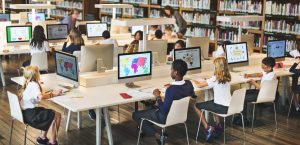Public schools have been doing business the same way since granddad was forced to walk to school uphill, both ways, with no shoes and in five feet of snow. Compare any classroom from those far-flung days against a modern version and – with the exception of a few tweaks to seating arrangements and tech upgrades – they won’t be all that different.
Despite the dominance of the ‘sit down and listen’ structure of most traditional learning environments, technology has been finding its way in through the cracks in a cash-strapped system in desperate need of change. Innovation is afoot, however, and ed-tech is moving beyond an “iPad for every child” model that many associate with technology use in schools. Joe Williams is the executive director of Democrats for Education Reform and he believes that change has been slow to come to education.
“With some exciting exceptions, public schools are one of the few institutions in modern life that have not seen radical changes spurred by technology,” Williams said in a 2019 interview with Fast Company. “I’m not talking about having computers in classrooms, but rather a lack of any seismic shift in the way things are done because technology is making the work easier or more efficient.”
Despite the old adage that the more things change, the more they stay the same – it’s not likely to be true for much longer. The advent of artificial intelligence, cloud-based services and big data, augmented & virtual reality, and robotics are currently shaping both the present and the future for learners at every age. One of the central themes emerging from discussions about digital transformation is empowering learners and their families in the educational process.
The rise of the SaaS-based services has redefined how companies view their relationship with customers and the education industry is no different. Empowering student learners is a central theme that emerges in discussions about digital transformation – whether that’s through tailoring approaches to individual learning styles, to making resources available to users who normally wouldn’t have access to them, and engaging students via methods like mobile apps to ensure their voices are heard when important decisions are being made. The service user is the student and everyone wants to keep the user happy.
By all appearances, Jill Watson was a new teaching assistant assigned to help professor Ashok Goel run his artificial intelligence class at Georgia Institute of Technology. She sent out emails to students about assignments and due dates and while they were brief, they were helpful and informative. It wasn’t until the end of the school year that students learned that Jill was a chatbot that Goel built to help reduce the work load for his other eight assistants.
“We thought that if an AI TA would automatically answer routine questions that typically have crisp answers, then the (human) teaching staff could engage the students on the more open-ended questions,” Goel said in an interview Digital Trends. “It is only later that we became motivated by the goal of building human-like AI TAs so that the students cannot easily tell the difference between human and AI TAs. Now we are interested in building AI TAs that enhance student engagement, retention, performance, and learning.”
Schools will become more than the bricks and mortar that make the buildings. Classrooms will be connected communities where students and teachers can form relationships with others just like them spanning the globe. Digital-native students will be able to expand their understanding by reaching out to real-world experts and scientists – education will become a more individualized experience that learners can explore independently. They will be consumers who can choose their own way to engage with those aspects of the material that appeal to them most.
Barriers to learning are also being broken down as technology helps student circumvent processing difficulties like dyslexia and visual perceptual/visual motor deficits. Voice-to-text and text-to-voice transcription help students overcome what would have been, at one time, a very debilitating condition. Other technologies like augmented/virtual realities can help other children experience situations they might not otherwise be able to due to physical limitations. Online learning options available in audio/video formats give students options for adapting the material to their own unique situation.
But technology can only be part of the transformative story. Despite all the obvious flash and bang benefits of innovation, one thing that will not change is the heart of the education endeavor – teachers. Technology cannot replace the brimming enthusiasm, open curiosity, and patient hand of those who guide students on their paths to becoming who they want to be.
























